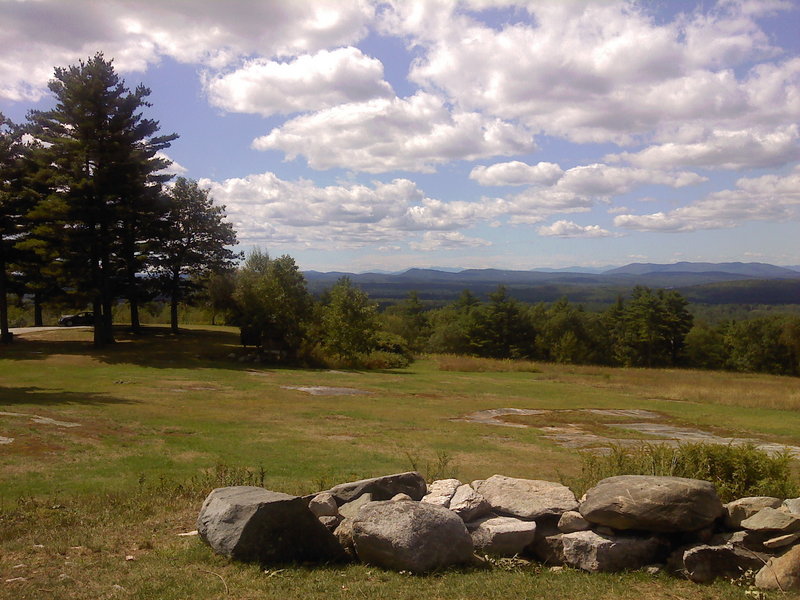One of the most prominent geologic features in the Lakes Region is Hacker’s Hill in Casco, a hilltop on Quaker Ridge Road affording one of the most stunning vistas in the entire Lakes Region.
Rising more than 750 feet above sea level – about 430 feet above Sebago Lake – the parcel offers the chance to savor a nearly 360-degree panorama from its peak. This is all thanks to the Hall family, current owners of the parcel. Hall ancestor Hacker Hall cleared much of the land so that you can drive right to the top.
The Halls have recently offered the acreage for sale. Loon Echo Land Trust is in the midst of a capital campaign to raise $800,000 that will ensure this open space remains accessible to the public for all time.
All time. It’s an interesting concept, especially when you consider the region’s geology, which is evident all over Hacker’s Hill.
Loon Echo Land Trust’s first organized event was scheduled for Tuesday. Geologists Walter Anderson and Robert Marvinney were planning to give an account of the geology of the Lakes Region and the hill itself.
“The Sebago Granite is one of the biggest rock formations in the state of Maine,” said Anderson, chief geologist of the international Appalachian Trail and former Maine state geologist. “It extends all the way to New Hampshire.”
Anderson says the rock on Hacker’s Hill is about 260 million years old and is part of the Appalachian Mountain chain.
“The hill is one of the final stages in the forming of the Appalachian Mountains,” Anderson said. “Two hundred and 67 million years ago, if you were there on that hill as it is today, you’d be some eight miles below the peak of the original mountain.”
That’s right. Our area was home to some of the tallest mountains the world has ever seen: some 40,000 feet – another two miles taller than Mount Everest.
“The Appalachians are old mountains,” Anderson said. “They’re not like the (Swiss) Alps. We know their age because we’ve dated the rocks.”
But Anderson said the towering height is only part of the story. More recently, Hacker’s Hill was almost certainly an island formation; the Atlantic Ocean surrounded the entire hill. Sebago Lake was part of the ocean; the hills and mountains along Sebago’s western shore were coastline.
Most of us have heard the history of the glaciers. Some 13,000 to 15,000 years ago, Sebago Lake and the surrounding area were under one to two miles of solid ice.
“This ice was an immense weight on the crust of the earth,” Anderson said. “The crust subsided, or sunk. Then when the ice retreated, which happened rather rapidly, the Atlantic Ocean came in right up to the ice. We can see this in the glacial sediments on the flanks of Hacker’s Hill. We find marine sediments with fossils in them.”
These fossils have been dated using carbon-14 technology. Anderson says the fossils are associated with Arctic and sub-Arctic species. Our climate was much different than it is today. Eventually, the Earth’s crust rebounded and the sea retreated to its current position.
Anderson and other geologists can read this story just by standing atop Hacker’s Hill.
“If you have a geologic map with you, you can see it,” Anderson said. “Hacker’s Hill is a unique place. There have been many field trips up there. There’s glacial gouging to be seen; there’s quite a story that unfolds.”
Loon Echo Land Trust plans on hosting other events, including a hawk migration watch from 9 a.m. to 3 p.m. Sept. 11. For details on the campaign, visit www.loonecholandtrust.org or call 647-4352.
Don Perkins is a freelance writer who lives in Raymond. He can be reached at: presswriter@gmail.com
Send questions/comments to the editors.



Success. Please wait for the page to reload. If the page does not reload within 5 seconds, please refresh the page.
Enter your email and password to access comments.
Hi, to comment on stories you must . This profile is in addition to your subscription and website login.
Already have a commenting profile? .
Invalid username/password.
Please check your email to confirm and complete your registration.
Only subscribers are eligible to post comments. Please subscribe or login first for digital access. Here’s why.
Use the form below to reset your password. When you've submitted your account email, we will send an email with a reset code.